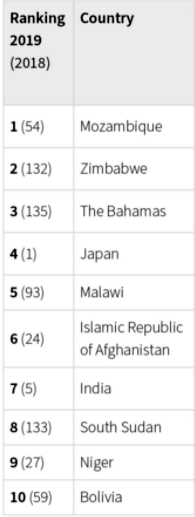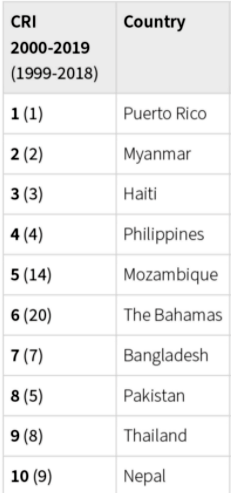Biodiversity & Environment
Global Climate Risk Index 2021
- 14 Oct 2021
- 5 min read
Why in News
The international environmental think tank ‘Germanwatch’ released the Global Climate Risk Index 2021.
- This is the 16th Edition of the Index. It is published annually.
- Germanwatch, based in Bonn and Berlin (Germany), is an independent development and environmental organisation which works for sustainable global development.
Key Points
- About the Index
- The Index analyses the extent to which countries and regions have been affected by the impacts of weather-related loss events (storms, floods, heat waves etc.).
- The impact is calculated in terms of fatalities and economic losses, both.
- The most recent data available for 2019 and from 2000 to 2019 were taken into account.
- The 2021 Index does not include data from United States of America.
- The Climate Risk Index clearly signals that repercussions of escalating climate change can no longer be ignored, on any continent or in any region.
- Impacts from extreme-weather events hit the poorest countries hardest as these are particularly vulnerable to the damaging effects of a hazard, have a lower coping capacity and may need more time to rebuild and recover.
- High-income countries are also getting severely impacted by climate change.
- About 2021 Findings

- Mozambique, Zimbabwe as well as the Bahamas were the most affected countries in 2019.
- For the period from 2000 to 2019, Puerto Rico, Myanmar and Haiti rank highest.
- Storms and their direct implications- precipitation, floods and landslides, were one major cause of losses and damages in 2019.
- Of the ten most affected countries in 2019, six were hit by tropical cyclones. Recent science suggests that the number of severe tropical cyclones will increase with every tenth of a degree in global average temperature rise.
- Eight out of the ten countries most affected by the quantified impacts of extreme weather events in 2019 belong to the low- to lower-middle income category. Half of them are Least Developed Countries.
- India’s Position:
- India has improved its rankings from last year. It is ranked 7th in the 2021 Index as compared to 5th in 2020 Index.
- The Indian monsoon lasted a month longer than usual in the year 2019, with surplus rains causing major hardship.The rain was 110% of normal, which is the most since 1994.
- The floods caused by heavy rains were responsible for 1800 deaths and led to displacement of 1.8 million people.
- Overall, 11.8 million people were affected by the intense monsoon season and the economic damage caused was estimated to be US$ 10 billion.
- India was hit by a total of 8 tropical cyclones. Of which, Cyclone Fani (May, 2019) caused the maximum damage.
- The Himalayan glaciers, the coastlines, and the deserts in India have been severely affected by global warming.
- The Report also points to an increase in the number of heat waves, increased intensity and frequency of cyclones and an increased rate of melting of glaciers in India.
- Suggestions:
- The global Covid-19 pandemic has reiterated the fact that both risks and vulnerability are systemic and interconnected. It is therefore important to strengthen the resilience of the most vulnerable against different types of risk (climatic, geophysical, economic or health-related).
- After the international climate policy process stalled in 2020 due to the Covid-19 pandemic, expectations regarding progress on the long-term finance goal and adequate support for adaptation lie in 2021 and 2022.
- The process needs to deliver:
- a decision on how the need for support for vulnerable countries concerning future loss and damage is to be determined on an ongoing basis.
- the necessary steps to generate and make available financial resources to meet these needs.
- strengthening the implementation of measures for adapting to climate change.
- Effective climate change mitigation and adaptation to prevent or minimize potential damage.




